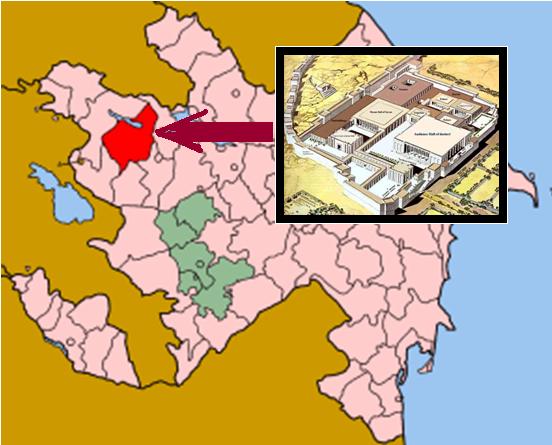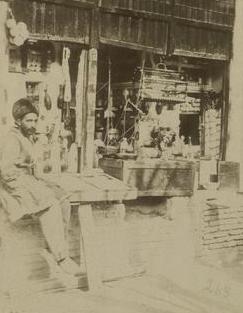The article below by Professor Aleksandre Gvakharia regarding Georgian-Persian literary contacts first appeared in the Encyclopedia Iranica. Kindly note that version printed below article below by Professor Aleksandre Gvakharia is different in that in the Encyclopedia Iranica in that it has embedded photographs and captions used in Kaveh Farrokh’’s lectures at the University of British Columbia’s Continuing Studies Division and Stanford University’s WAIS 2006 Critical World Problems Conference Presentations on July 30-31, 2006. There are also two videos below which highlight traditional Georgian music with it cultural links to Iran.
=====================================================
The tribes of Georgia had a well-established and vast literary tradition and folklore long before the Christian era. None of the pre-Christian Georgian literary works have survived, however. Christianity became established in Georgia as an official religion at the beginning of the 4th century, and in the 5th century the first surviving literary work, Tsamebay tsmidisa Shushanikisi (The martyrdom of Shushanik) by Jacob Tsurtaveli (ed. M. Malazonia and I. Lolasvili, Tbilisi, 1986), which laid the foundation of Georgian clerical literature, was created. By that time some biblical texts, such as the Psalms and the New Testament, had been already translated. Hagiographic literature (e.g., martyrology and lives of the saints), although serving primarily the interests of the Church, contained elements of fiction and historiography. Georgian hagiographical works on the passions of St. Shushanik, St. Evstate Mtskheteli (6th cent.), and St. Abo Tbileli (8th cent.), as well as lives of St. Nino (9th cent.), and St. Grigol Khandzteli (10th cent.), testify to the development of literary style and to the high artistic level of Georgian hagiographers and hymnographers. These literary activities finally led to the appearance of Georgian secular literature in the 11th cent.
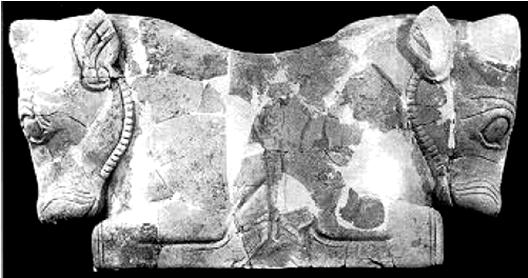
Ancient Georgian Column Capital discovered in Tsikha Gora (Courtesy of Gagoshidze and Kipiani). Note the striking resemblance to the column capital from Persepolis below (Picture and caption from Kaveh Farrokh’’s lectures at the University of British Columbia’s Continuing Studies Division and were also presented at Stanford University’s WAIS 2006 Critical World Problems Conference Presentations on July 30-31, 2006).
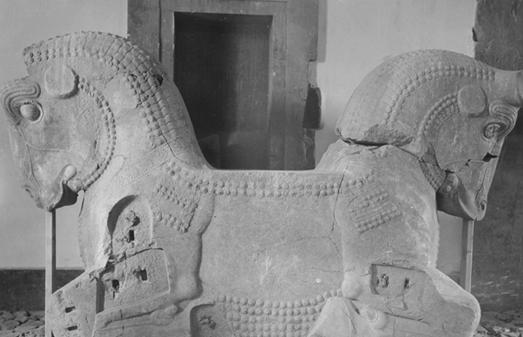
The double-bull motif column capital typical of Achaemenid-era architecture in sites such as Persepolis and Susa. Note the vivid parallels in style, construction and motifs to its Georgian counterpart. Architecture is only one of the many facets in which the ancient Caucasus and Persia have enjoyed mutual influences (Picture and caption from Kaveh Farrokh’’s lectures at the University of British Columbia’s Continuing Studies Division and were also presented at Stanford University’s WAIS 2006 Critical World Problems Conference Presentations on July 30-31, 2006).
The familiarity of Georgian authors with the Persian classics also played a significant role in the development of Georgian literature. Such works as the epic romance Amirandarejaniani ascribed to Mose Khoneli (12th century; N. Marr, 1895), Tamariani by Grigol Chakhrukhadze (12th century), Abdulmesiani by Iovane Shavteli and, finally, the masterpiece of Georgian poetry Vepkhistqaosani (The man in the panther skin) by Shota Rustaveli, came into being due to this cultural synthesis (Allen, pp. 318-20).
The beginning of Georgian-Persian literary contacts is usually traced back to the 11th-12th centuries, when Georgian secular literature first developed and flourished. However, the roots of Georgian-Persian cultural, linguistic, and literary contacts run much deeper. Unfortunately, very little evidence is preserved from the earlier periods, so traces of these contacts must be sought in linguistic data, in artifacts, in chronicles, and in later literary works.
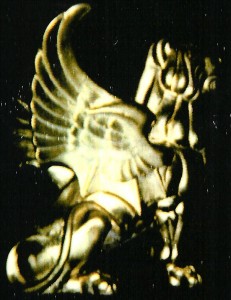
Preliminary photo of the golden Winged-Lion of Meskheti (Copyright of Georgian Academy of Sciences and Manuscripts, Tbilisi, Georgia). Georgian Iranologists and the Georgian Academy of Sciences have determined that the origin of this lion is from Iran. The reports of the study have been transferred to Kaveh Farrokh to be compiled for publication (Picture and caption from Kaveh Farrokh’’s lectures at the University of British Columbia’s Continuing Studies Division and were also presented at Stanford University’s WAIS 2006 Critical World Problems Conference Presentations on July 30-31, 2006).
The 11th-century Georgian chronicle Kartlis tskhovreba (The annals of Georgia) mentions two persons: Parnavaz, the king of Georgia, and Artavaz (see ARTABAZUS, ARTAVASDES in Encyclopedia Iranica), the foster-brother of king Vakhtang Gorgaslan (Justi, Namenbuch, p. 92; Huyse, 23a). Not only is the Iranian origin of their names interesting, but also their connection with Iranian epic traditions. Parnavaz is associated with the creation of a Zoroastrian sanctuary at Armazi (q.v.), the ancient capital of Georgia near the present-day Mtskheta, where a bilingual inscription in Greek and Middle Iranian has been found (Metzger). Some scholars (e.g., Bailey, Dictionary, p. 40; Lang, 1966, pp. 88, 152-53; Andronikashvili) trace the term Armazi, which is also the name of a deity in the Georgian pantheon, to Ahura Mazdā (q.v.).
Stories about Artavasdes, Bēvrasp/Ažī Dahaka (Aždahāg), Ardašīr, Afrāsīāb (qq.v.), and other heroes of ancient Iranian legends were widespread in Georgia. The Kartlis tskhovreba contains a passage referring to a well-known episode in the Šāh-nāma that seems to indicate that the author was familiar with a Persian literary work similar to the Xwadāy-nāmag. The passage reads: “And then Iranians from the side of the sunrise, the kin of Nebrot, became strong. And there appeared among them one man, a hero named Afridon
There are two noteworthy points in this short passage: “the side of the sunrise” is obviously a Georgian translation of Xᵛarāsān “the place whence the sun rises,” and “Bevrasp, the master of snakes” is no doubt Bēvarasp Aži Dahāka (for him in Iranian mythology see Christensen, pp. 20-24). The first part of Bēvarasp is left without translation (in Ancient Georgian bevri, as the Av. baēvar– and the Mid. Pers. bēwar, means “ten thousand,” in Modern Georgian it means “many”), while the phrase “the master of snakes” is a literal translation of Aždahāg (see AŽDAHĀ). The meaning of aži- “snake, dragon,” is well known, while different interpretations have been suggested for dahāg. According to the Georgian source it stands for “master, lord.”
An Iranian legacy in the Caucasus. To the south of the Republic of Georgia is Shamkhir located in the Republic of Azarbaijan (ROA) (known as Arran until 1918). Shamkhir is located some 350 kilometres west of Baku near the Armenian border to its west. The CAIS website hosted by Shapur Suren-Pahlav reported on August 28, 2007 that Archaeologists from the ROA, Georgia and Germany unearthed ruins of a monument dated to the Achaemenid dynasty in the town of Shamkhir. The head of the archaeology team stated that: “During the excavation, we found traces of a 2500 year old historical structure…which has one 1000 square meter chamber surrounded by several smaller rooms…The ruins indicate that this area was once an important Achaemenid centre in the northern provinces in the Caucasus” (Picture and caption from Kaveh Farrokh’’s lectures at the University of British Columbia’s Continuing Studies Division and were also presented at Stanford University’s WAIS 2006 Critical World Problems Conference Presentations on July 30-31, 2006).
The conversion of Georgians to Christianity in the 4th century, and then the conquest of Persia and parts of Georgia by the Arabs three centuries later, temporarily interrupted the cultural contacts between the two countries. At that time (7th-9th centuries) Georgian-Arab literary connections were developed, some works were translated from Arabic into Georgian, among them the world-famous novel of Buddhist origins about Barlaam and Joasaph (Pers. Belawhar o Būdāsaf, q.v.), known in Georgian as the Balavariani.
With the rise of the New Persian literature during the 9th-10th centuries, literary contacts between the two cultures resumed and even became much stronger than before. It appears that Georgians became familiar with Persian literary classics quite early. In the 9th-century work Moktsevai Kartlisai (The conversion of Georgia), a whole phrase in Persian, transcribed in Georgian letters, is put into the mouth of the Georgian king Mirian. This corrupted text (raĭtmeboĭ khodzhat stabanug rasul psarzad) was restored by Nikolaĭ Yakovlevich Marr (1897, p. 72) with the help of a Georgian translation given in a 10th-century manuscript: “rāst mīgūī ḵojasta bānū wa rasūl-e pesar-e īzad” (You are speaking the truth, blessed lady and the messenger of the Son of God). This passage is important for several reasons: the presence of the Arabic word rasūl shows that this Georgian literary work can be dated no earlier than the 7th century; its transliteration and translation are interesting from the point of view of historical linguistics; and finally, it suggests that Georgian contacts with Persia (and hence with New Persian literature) may have been established much earlier than suspected before.
The cultural and political renaissance of Georgia is connected with the name of King David II, surnamed Aghmashenebeli (the Builder; r. 1089-1125). A well-educated man, poet, and philosopher, he maintained relations both with the Christian world and with Islamic countries. During his reign, relations were especially close with the state of Šarvān, where a Persian school of poetry flourished, continuing the classical traditions of Rūdakī, Ferdowsī’s Šāh-nāma, the epic and lyrical heritage of ʿOnṣorī, Farroḵī Sīstānī, Manūčehrī, Faḵr-al-Dīn Gorgānī’s Vīs o Rāmīn, etc. The familiarity of Georgian society with the works of these classical masters and with the master poets of Šarvān, including Neẓāmī Ganjavī, Ḵāqānī Šarvānī, Falakī Šarvānī, etc., helped further literary contacts between Georgia and Persia.
A unique photo of a 19th century Persian pharmacy and apothecary in old Tbilisi, Georgia. Despite the imperial Russian conquests of the early 19th century and subsequent Czarist (and later Communist) efforts to “de-Persianize” the Caucasus, modern-day Georgians do acknowledge an Iranian legacy in their country (see Nowruz in Georgia and the Georgian Legacy in Iran) (Picture courtesy of Dr. David Khoupenia with caption from Kaveh Farrokh’’s lectures at the University of British Columbia’s Continuing Studies Division and were also presented at Stanford University’s WAIS 2006 Critical World Problems Conference Presentations on July 30-31, 2006).
The growth of cities set the necessary condition for the revival of cultural activities. Frequent receptions and feasts at the royal and feudal courts attracted panegyrists, story-tellers (qeṣṣaḵᵛān), and singers not only from all parts of Georgia but also from neighboring countries as well as from distant lands. Chakhrukhadze, the historian of Queen Tamar (r. 1184-1212), describes the arrival of the Šarvānšāh at the head of a large retinue, undoubtedly including poets, since Ḵāqānī Šarvānī alludes to such an occasion in the description of his journey to Tbilisi in his Maṯnawī. He mentions a number of Georgian place-names: Mukhrani, Nacharmagevi, the summer-palaces of the royal Bagrationi family (eg., Dīvān, pp. 25, 53, 438, 512, 742). He also indicates his knowledge of Georgian (gorjīgūy) and use a Georgian word (mui, “come”) in one of his rhymes (Y. Marr). The poet Falakī wrote an elegy (marṯīya) on the death of Dmitri I (r. 1125-1156), the king of Georgia. Neẓāmī Ganjavī often mentions and describes Georgia (Abḵaz, which then referred to all of Georgia) in his poems Ḵosrow o Šīrīn and Eskandar-nāma (Y. Marr).
Almost every page of Georgian literary works and chronicles (e.g., the verse collection Tamariani, the poem Abdulmesiani, Rustaveli’s Vepkhistqaosani, etc.) contains names of Iranian heroes borrowed from the Šāh-nāma (e.g., Rostam, Kai-Khosrow, Zāl, Tūr), from Yūsof o Zolayḵā (Ioseb [Yūsof], Zelikha/Bazika), from Vīs o Rāmīn (Vis, Ramin, Mobad), from Salāmān o Absāl (Salaman), from Neẓāmī’s Laylī o Majnūn (Leili, Kais, Majnun), and from ʿOnṣorī’s Vāmeq o ʿAḏrā (Vamek), Šādbahr, and ʿAyn-al-Ḥayāt (Shatbiar, Analat), etc. It seems that Georgian readers of the classical period either had Georgian versions of the poems by Ferdowsī, ʿOnṣorī, Gorgānī, Neẓāmī, and of works like the Kalīla wa Demna, Ḥātem Ṭayy, and the Qābūs-nāma, or were quite well acquainted with the original texts.
Of this long list, however, only one Georgian version of Visramiani has survived, a complete prose translation of the poem Vīs o Rāmīn by Faḵr-al-Dīn Gorgānī (Abuladze, 1935; Mamatsashvili, 1967; Kobidze, 1967; idem, 1969).
Traditionally this translation is ascribed to Sargis Tmogveli, a 12th-century statesman and writer. This Georgian version of the medieval Persian romance, which fully retained the spirit of the original, considerably influenced all further development of Georgian prose. Its proximity to the Persian original made it possible to use the Persian text when preparing the critical edition of Visramiani (eds. A. Gvakharia and M. Todua, Tbilisi, 1962). This Georgian translation, being the oldest known manuscript of the work and preserving a more complete version than the few known manuscripts of the Persian text, helps restore corrupted lines and determine the more reliable variants found in different Persian manuscripts that generally are of later origin (17th-18th cent.) and have many lacunae and corrupted parts. The Georgian Iranologists Magali Todua and Alexandre Gvakharia produced a critical edition of Vīs o Rāmīn (Tehran, 1970), which for the first time contains variants of the text found in different manuscripts. The edition was based on the Georgian translation of the poem, the surviving Persian manuscripts, and the three earlier editions (1864, 1935, and 1959).
The above video shows a version of the Ajameti Music and dance of Georgia. “Ajameti” in Georgian refers to Iran and Iranians. The Ajameti dance and music piece was popular in Iran up to the early twentieth century. Note the parallels of this music to the Rashti music of Gilan province in northern Iran.
Georgia entered a period of cultural decline in the 13th-15th centuries, during which it suffered devastating foreign invasions. The so-called renaissance of Georgian literature began only towards the end of the 15th century. At that time, as in the classical period, translations of Persian works, mainly Georgian versions of the Šāh-nāma, continued to play a prominent part in the revival of the national culture along with original Georgian literary works.
The Georgian versions of the Šāh-nāma comprise a large collection of renderings of various episodes in prose and verse, generally known as the Rostomiani (The legend of Rostam). It evolved in the course of three centuries (15th-17th cent.) and included the works of several authors (Salva Sabashvili, Khosro Turmanisdze, Baradzim Vachnadze, Parsadan Gorgijanidze) whose works ranged from exact translations to free renderings of different episodes, most of them by that time interpolated, since there already existed Georgian versions of Bahman-nāma (Baamiani, Utrutian-Saamiani), etc. The complete edition of the Georgian versions of the Šāh-nāma has been published in three volumes (I, ed. I. Abuladze, Tbilisi, 1916; II, ed. I. Abuladze et al., Tbilisi, 1934, on the occasion of the millenary celebration of Ferdowsī, q.v.; III, ed. D. I. Kobidze, Tbilisi, 1974).
During the 16th-18th centuries, close relations with the countries of the Middle East, especially with Persia, influenced considerably the way of life and the culture of some segments of Georgian society. In one of his letters to Rome, Padre Bernardi, a Catholic missionary from the 17th century, mentions with great regret that Georgian readers prefer such books as Bezhaniani, Rostomiani, and Baramguriani and pay less attention to religious works. The first two compositions belong to the Georgian Šāh-nāma cycle, the last one is a Georgian version of the legend of Bahrām Gōr (q.v.). The author of Baramguriani, Nodar Tsitsishvili (17th cent.), claimed that he was well-acquainted with the poems of Neẓāmī, Amīr Ḵosrow Dehlavī, ʿAlī-Šēr Navāʾī, and ʿAbd-al-Raḥmān Jāmī (even though the last poet is not known to have treated directly this particular subject), and used them as sources for his original Georgian version.
The genre of romance and adventure was as popular in Georgia as that of the heroic epic. The Georgian version Iosebzilikhaniani, which was based on earlier versions of Jāmī’s poem Yūsof o Zolayḵā, appeared as early as the 16th century (Gvakharia, 1958). It has survived in a single corrupted manuscript containing twelve very fine miniatures taken from an earlier manuscript. The text of this anonymous poem mentions a certain Zaal, who is probably the author of the Georgian version of this ancient story, which is found both in the Bible and in the Koran.
King Teimuraz/Ṭahmūraṯ I (r. 1603-63) deserves special notice here, because his life was closely connected with the history of political relations between Persia and Georgia. This poet-king was born in Persia, was proficiently fluent in Persian, and appreciated and highly valued Persian poetry. His mother, queen Ketevan, his sons, and finally Teimuraz himself all died in Persia. Commenting on his interest in the Persian language, he said: “The sweetness of Persian speech urged me to compose the music of verse.” Teimuraz wrote a collection of five poems (on the model of a ḵamsa) that included Iosebzilikhaniani (another version of Joseph’s story), Shamiparvaniani (The candle and the moth), Vardbulbuliani (The rose and the nightingale), Leilmajnuniani (a version of Laylī wa Majnūn; Mamatsashvili, 1967), and Ketevaniani, a historical poem on the martyrdom of his mother. He is also the author of several strife poems (monāẓara), including “A dispute between spring and autumn” and “A dispute between the wine and the lips.” His poetry is full of Persian imagery and allusions, loanwords, and phraseology (Jakobia; Mamatsashvili, 1967).

King Teimuraz/Ṭahmūraṯ I (r. 1603-63) of Georgia portrayed with his wife and Queen, Khorashan. Teimuraz was born in Iran and was fluent in Persian – he was highly appreciative of Persian poetry and literature. Teimuraz’s sons, his mother Queen Katevan (Georgian for Katayoun) and himself were to all to pass away in Iran (Picture courtesy of Dr. David Khoupenia with caption from Kaveh Farrokh’’s lectures at the University of British Columbia’s Continuing Studies Division and were also presented at Stanford University’s WAIS 2006 Critical World Problems Conference Presentations on July 30-31, 2006).
Didactic works, such as collections of parables and exhortations so well-represented in Persian literature, were also very popular among Georgian readers. In the 16th century an anonymous Georgian author translated from Persian a collection of exhortations (“On temperance,” “On justice,” “On generosity,” etc.), illustrated with parables and anecdotes, e.g., “Sultan Sanjar and the beggar”; “The king and the sepah-sālār, who was bitten by a scorpion”; “Memul/al-Maʾmūn, the caliph of Baghdad, and the bedouin Arab”; “King Bahrām Gōr, the gardener, and the pomegranate” (published in S. Qubaneishvili, Zveli k’art’uli literaturis krestomathia [Chrestomathy of Old Georgian literature] II, Tbilisi, 1949). The unique manuscript is defective, giving neither title nor information about the translator and the Persian source; it has tentatively been called “Treasury of the Kings,” a parallel to the title of Ḏaḵīrat al-molūk by Mīr Sayyed ʿAlī Hamadānī (d. 786/1384).
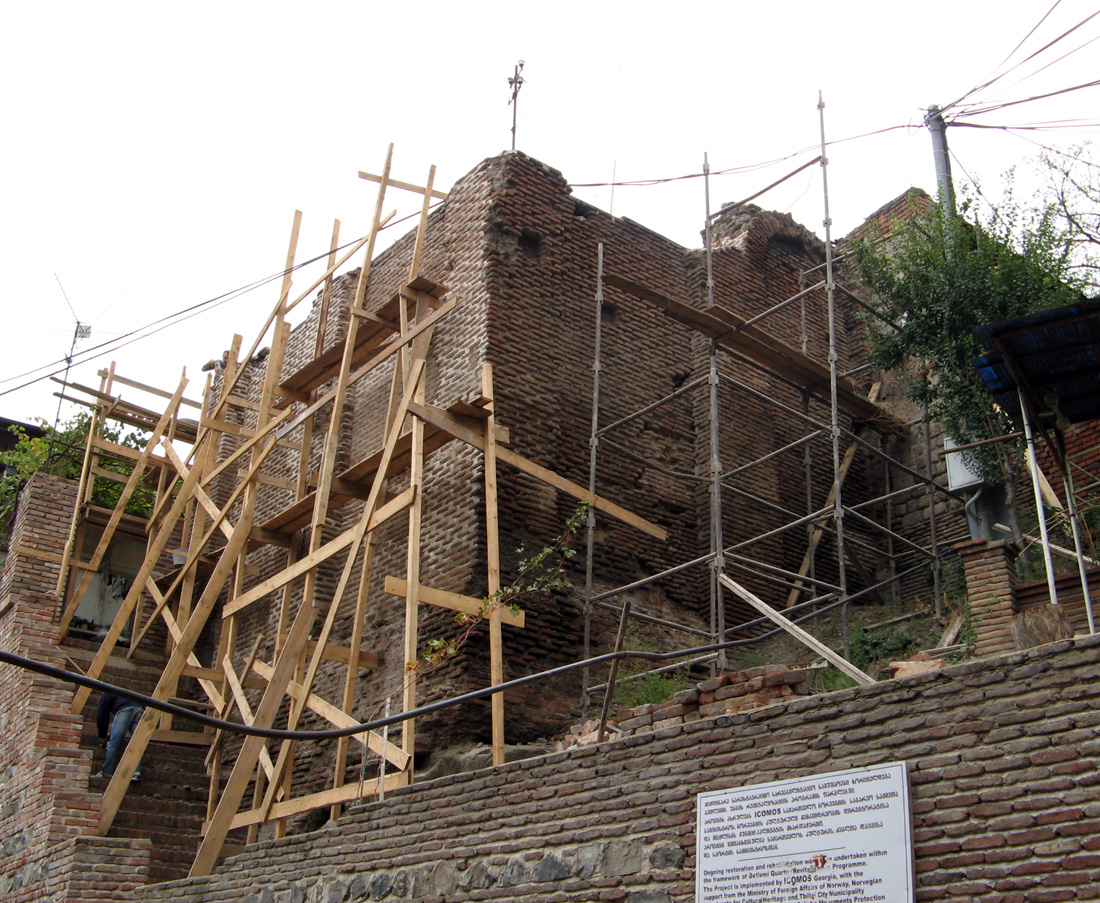
Remains of an “Atash-kade” (Zoroastrian fire-temple) undergoing repairs in Georgia. The cultural ties between Iran and Georgia stretch back for thousands of years (Picture courtesy of Dr. David Khoupenia with caption from Kaveh Farrokh’’s lectures at the University of British Columbia’s Continuing Studies Division and were also presented at Stanford University’s WAIS 2006 Critical World Problems Conference Presentations on July 30-31, 2006).
King Vakhtang VI (r. 1711-14, 1719-23) played a significant part in the further development of Georgian-Persian literary contacts. During his long stay in Persia, Vakhtang not only mastered the language but also gained an understanding of the literary styles and trends and selected certain works to be translated into Georgian. He composed both prose and verse translations of the 11th-century mirror for princes Qābūs-nāma, known also as Andarz-nāma (q.v.), by ʿOnṣor-al-Maʿālī Kaykāvūs b. Eskandar, which appeared under the title Amirnasariani (The story of Amirnasar [i.e., Kaykāvūs]). Of the forty-four chapters of the Persian original, Vakhtang selected only eleven, the ones that he thought would appeal most to Georgian readers. He also played an important part in the creation of three Georgian versions of Kalīla wa Demna (an anonymous translation completed on Vakhtang’s order; a word for word translation by Vakhtang himself during his stay in Persia; and a revision of Vakhtang’s literal translation by his tutor, the writer Sulkhan Saba Orbeliani), based on the 15th-century work Anwār-e sohaylī (q.v.) by Ḥosayn Wāʾeẓ Kāšefī (Baramidze, 1975; Todua, 1975). Apart from his personal contribution to Georgian literature, Vakhtang founded a whole school of translators from Persian into Georgian. As attested in the manuscripts, several folk dāstāns that were then very popular in Persia were translated into Georgian on his direct order. Among them were Baḵtīār-nāma (a Persian collection of novellas), Baramgulandamiani (from the Persian Bahrām o Gol-andām of Kātebī Nīšābūrī), and Khosrovshiriniani (a popularized version of Šīrīn o Ḵosrow by Amīr Ḵosrow Dehlavī, q.v.).

King Vakhtang VI (r. 1711-14, 1719-23) did much to foster the literary contacts between Persia and Georgia (Picture courtesy of Dr. David Khoupenia with caption from Kaveh Farrokh’’s lectures at the University of British Columbia’s Continuing Studies Division and were also presented at Stanford University’s WAIS 2006 Critical World Problems Conference Presentations on July 30-31, 2006).
During the 17th-18th centuries there appeared translations like Miriani (from the Persian Mehr o Māh), Chardarvishiani (after the famous book Qeṣṣa-ye čahār darvīš), Karamaniani (a huge collection of stories deriving from the Qahramān-e qātel and translated by David Orbeliani [1716-96]), and others. Some of these translations are anonymous. Most of them, even if they are given some local Georgian color, follow their Persian originals very closely.
The Georgian National Ballet Sukhishvili – note the parallels of the music with respect to traditional Iranian instruments and melodies – note especially the parallels with the music of Azarbaijan province in northwest Iran.
A number of other works in Georgian literature are undoubtedly of Persian origin, although their sources are either lost or not yet established. Among them are the novels Seilaniani, possibly a rendition of Sehelan-nāma (a Persian work mentioned in Barthélémy D’Hèrbelot’s Bibliothèque Orientale), Varshakiani, Sirinoziani, Pirmaliani, etc. The study of these literary works presents certain difficulties, mainly because the dāstān literature of Persia, from which they originate, has so far received little attention; many of these dāstāns have never been published, and are not even described in catalogues. The same can be said about the Georgian versions. Research in this field is only now beginning (e.g., Gvakharia, 1968). Recently, Georgian versions of Razmašāh, Sayf-al-Molūk, and Qeṣṣa-ye Ḥamza have been discovered, their sources traced, and critical editions undertaken (though not yet published; the manuscripts are in libraries in Tbilisi and St. Petersburg). Several other texts have already been published, among them Bakhtiarname, Khosrovshiriniani, Karamaniani, and Rusudaniani (i.e., “The story of Rusudan,” an original collection of freely rendered Persian and Georgian folk stories, an adaptation of the dāstān genre in Georgia). Since the beginning of the 19th century, Persian-Georgian literary and cultural contacts have noticeably decreased. In 1828, Aleksandre Sulkhanashvili produced a prose translation of the Baḵtīār-nāma by Panāhī, an obscure 15th century poet. With the annexation of Georgia by Russia, Eastern themes and subject-matter were gradually replaced by Russian and European ones. The establishment of Tbilisi State University in 1918, however, revived scholarly interest in Iranian studies by offering relevant courses and training scholars who continued the work and promoted the interest in other academic and educational institutions of Georgia. The area of special interest was Persian-Georgian linguistic and literary contacts from a historical as well as modern perspective. Publications on the subject include monographs on various literary works, essays on the history of Persian literature and on Persian-Georgian cultural relations, text editions, and textbooks. An important subject of study is the reflection of Georgian history and culture in Persian sources. The old tradition of translating Persian works into Georgian has been revived. The lyrics of Rūdakī, ʿOmar Ḵayyām, Rūmī, Ḥāfeẓ, Jāmī, can now be read in the language of Rustaveli. There are new translations of the poems by Neẓāmī and Saʿdī; a new Georgian translation of the Šāh-nāma is in progress. Samples of Persian folklore and Old Iranian and Middle-Persian literature like the Avesta, Kār-nāmag ī Ardašīr, Draxt ī āsūrīg (qq.v.) are now available to Georgian readers. Many works by modern Persian writers have been translated as well, among them Moḥammad-ʿAlī Jamālzāda, Ṣādeq Hedāyat, Ṣādeq Čūbak, Saʿīd Nafīsī, Ḵosrow Šāhānī, Jamāl Mīr-Ṣādeqī, Ḡolām-Ḥosyan Sāʿedī, etc.
Bibliography:
Iu. Abuladze, “Visramiani tekstisathvis” (Towards the text of Visramiani), in Literaturuli memkvidreda (Literary heritage) 1, 1935, pp. 270-97.
W. E. D. Allen, A History of the Georgian People, 2nd ed., New York, 1971.
M. Andronikashvili, Narkvevebi iranul-kartul enobrivi urtiertobidan (Essays on Iranian-Georgian linguistic contacts), Tbilisi, 1966.
A. G. Baramidze, Pirdousi da misi Šah-name: mokle istoriul-literaturuli mimokhilva (Ferdowsī and his Šāh-nāma), Tbilisi, 1934.
Idem, Issledovaniya iz istorii gruzinskoĭ literatury (Studies on the history of Georgian literature) I, Tbilisi, 1945 (in Georgian).
Idem, “Nizami i gruzinskaya literatura” (Neẓāmī and Georgian literature), Trudy Tbilisskogo universiteta 32, 1947, pp. 139-44 (in Georgian).
Idem, “Literaturnye svyazi drevneĭ Gruzii” (Literary contacts of ancient Georgia), in Vzaimosvyazi i vzaimodeĭstviya natsional’nykh literatur, Moscow, 1961, pp. 403-407.
Idem, “Kilila da Damanas sakitkhebi” (Versions of Kalīla and Demna) in idem, ed., Narkvevebi kartuli literaturis istoriidan (Studies on the history of Georgian literature) VI, Tbilisi, 1975.
A. G. Baramidze and D. M. Gamezardashvili, Georgian Literature, Tbilisi, 1968.
Grigol Chakhrukhadze, Tamariani, ed. as Keba mepisa Tamarisi in I. Lolashvilii, ed., Zveli kartveli mexotbeni (Old Georgian ode-writers) I, Tbilisi, 1957.
A. Christensen, Essai sur la démonologie iranienne, Copenhagen, 1941.
N. Dundua, Kartul-sparsuli (orenovani) istoriuli sabutebi XVI-XVIII ss. (Georgian-Persian bilingual historical documents, 16th-18th centuries), Tbilisi, 1984.
G. Garitte, “Littérature spirituelle géorgienne,” in Dictionnaire de spiritualité VI, Paris, 1965, pp. 244-56.
A. Gvakharia, “Iosebzilikhanianis” kartuli versiebis sparsuli tsqaroebi (Persian sources of the Georgian versions of Yūsof o Zolayḵā), Tbilisi, 1958 (summary in Russian).
Idem, Znachenie gruzinskikh perevodov persidskikh pamyatnikov dlya osveshcheniya nekotorykh voprosov persidsko-tadzhikskoĭ literatury (The significance of Georgian translations of Persian literary monuments for understanding certain problems of the Persian-Tajik literature), Tbilisi, 1960.
Idem, Sparsuli khalkhuri dastanebis kartuli versiebi: Bakhtiar-name (Georgian versions of Persian folk dāstāns: Baḵtīār-nāma), Tbilisi, 1968 (summary in Russian).
Idem, “Iz istorii gruzinsko-persidskikh literaturnykh vzaimootnosheniĭ” (On the history of Georgian-Persian literary contacts), in W. Tyloch, ed., Problemy literatur orientalnych (Problems in literatures of the East), International Symposium on the Theoretical Problems in the Investigation of Literatures of the East, Warsaw, 1974, pp. 77-81.
Idem, “Nekotorye aspekty gruzinsko-persidskikh literaturnykh vzaimootnosheniĭ v XVI-XVII vekakh” (Some aspects of Georgian-Persian literary contacts in the 16th-17th centuries), in F. Gruner, ed., Literaturen Asiens und Afrikas: theoretische Probleme, Berlin, 1981, pp. 37-42 (in Russian).
Idem, “Georgian-Persian Literary Contacts in the Twelfth Century,” in M. Galik, ed., Proceedings of the Fourth International Conference on the Theoretical Problems of Asian and African Literatures, Bratislava, 1983, pp. 294-301.
Idem, “Zum Ursprung der georgisch-persischen Literaturbeziehungen,” Georgica 10, 1987, pp. 44-47. Ph. Huyse, Iranischen Personennamenbuch, ed. M. Mayerhofer and R. Schmitt, Vienna, 1990. G. Jakobia, “Teimuraz pirvelis targmanebi” (The translations of Teimuraz I), in A. Baramidze and G. Jakobia, Teimuraz I, Tbilisi, 1934.
I. Kaladze (Kālādza), “Dāstānhā-ye romān-mānand dar zabān-e fārsī,” Āyanda 4-6, 1358 Š./1979, pp. 238-43. Idem, ed. and tr., Epicheskoe nasledie Unsuri/Mīrāṯ-ī az maṯnawīhā-ye ʿOnṣorī, Tbilisi, 1983 (in Russian and Persian, summary in English).
Idem, “Un ignoto intreccio romanzesco classico nella letteratura persana,” Annali della Facoltà di Lingue e Letterature Straniere di Ca’Foscari (Milan) 23/3, 1985, pp. 119-32.
Afżal-al-Dīn Ḵāqānī Šarvānī, Dīvān, ed. Ż. Sajjādī, Tehran, 1474 Š./1995. Karamaniani, tr. D. Orbeliani et al., ed.
A. Gvakharia, Tbilisi, 1965. Kartlis tskhovreba (The annals of Georgia), ed. S. Kaukhchishvili, 2 vols., Tbilisi, 1955-59.
K. Kekelidze, Etiudebi zveli kartuli literaturis istoriidan (Studies on the history of Old Georgian literature) IV: Gruziya i Nizami (Georgia and Neẓāmī), Tbilisi, 1957, pp. 81-89.
Idem, Karthuli literatauris istoria (History of Georgian literature) II, Tbilisi, 1958.
Mose Khoneli, Amiran darejaniani, ed. L. Atanelsvili, Tbilisi, 1967; Eng. tr. by R. H. Stevenson as Amiran-Darejaniani: A Cycle of Medieval Georgian Tales Traditionally Ascribed to Mose Khoneli, Oxford, 1958.
D. Kobidze, Šahnamas karthuli versiebis sparsuli tsqaroebi (Persian sources of the Georgian versions of the Šāh-nāma), Tbilisi, 1959.
Idem, “Of the Antecendents of Vis-u-Ramin,” in Yād-nāma-ye Yān Rīpkā, Prague, 1967, pp. 89-94.
Idem, “Visramianis sakitkhebi” (Questions about Vīs o Rāmīn) in idem, Kartul-sparsuli literaturuli urtiertobani (Georgian-Persian literary relations) II, Tbilisi, 1969.
Idem, “Saīd Naficy et la Géorgie,” in Mélange d’iranologie en mémoir de feu Said Naficy, Tehran, 1972, pp. 110-12. Idem, Kartul-sparsuli literaturuli urtiertobani (Georgian and Persian literary relations), 3 vols., Tbilisi, 1969-83 (summary in Russian).
D. M. Lang, The Wisdom of Balahvar: A Christian Legend of the Buddha, London and New York, 1957. Idem, The Georgians, New York and Washington, 1966.
M. Mamatsashvili, Teimuraz pirvelis “Leil-majnunianis” sparsuli tsqaroebi (Persian sources of Teimuraz I’s poem Leilmadjnuniani), Tbilisi, 1967.
Idem, “Vis o Ramin” Gurgani i gruzinskii “Visramiani” (Vīs o Rāmīn by Gorgānī and the Georgian Visramiani), Tbilisi, 1977 (in Georgian; summaries in Russian and French).
M. Mamatsashvili and J. Giunashvili, “On the Centenary of the First Edition of Visramiani,” in L. Magarotto and G. Scarcia, eds., Georgica I, Rome, 1985, pp. 119-25.
N. Y. Marr, “Persidskaya natsional’naya tendentsiya v gruzinskom romane Amirandaredzhaniani” (The Persian national theme in the Georgian romance of Amirandarejaniani), Zhurnal Ministerstva narodnogo prosveshcheniya (St. Petersburg), June 1895, pp. 362-65.
Idem, “K voprosu o vliyanii persidskoĭ literatury na gruzinskuyu” (On the problem of the influence of Persian literature on Georgian literature), Zhurnal Ministerstva narodnogo prosveshcheniya (St. Petersburg), March 1896, pp. 223-37.
Idem, “Khiton gospogen v kniinikh legendakh armian, gruzin i siriicev” (God’s tunic and Armenian, Georgian, and Syrian legend), Sbornik statei uchenikov Professora Barona Victora Romanovicha Rozena, St. Petersburg, 1897.
Idem, “Vozniknovenie i rastsvet drevnegruzinskoĭ svetskoĭ literatury” (Origins and heyday of Old Georgian secular literature), Zhurnal Ministerstva narodnogo prosveshcheniya (St. Petersburg), December 1899, pp. 223-52.
Idem, “Iz gruzino-persidskikh literaturnykh svyazeĭ” (On Georgian-Persian literary contacts), Zapiski Kollegii vostokovedov pri Aziatskom muzee Rossiĭskoĭ akademii nauk (Leningrad) 1, 1925, pp. 111-39.
Idem, Voprosy “Vepkhistkaosani” i “Visramiani” (Problems of Vepkhistqaosani and Visramiani), ed. I. V. Megrelidze, Tbilisi, 1966.
Y. N. Marr, Khakani, Nezami, Rustaveli, 2 vols., Moscow, 1935-66.
B. M. Metzger, “A Greek and Aramaic Inscription Discovered at Armazi in Georgia,” JNES 15, 1956, pp. 18-26.
S. Nafīsī, “Adabīyāt-e fārsī dar Gorjestān,” Mehr 2, 1313 Š./1934, pp. 746-49.
Idem, “Rawābeṭ-e adabīyāt-e Gorjestān wa Īrān,” Trudy Tbilsskogo universiteta 108, 1964, pp. 57-58.
D. Rayfield, The Literature of Georgia: A History, Oxford, 1994.
Shota Rustaveli, Vepkhistqaosani, ed. S. Kakabazis, Tbilisi, 1913; ed. A. Sanizisa and A. Baramizis, Tbilisi, 1966; tr. M. S. Wardrop as The Man in the Panther’s Skin: A Romantic Epic, London, 1912, Tbilisi, 1966; tr. K. Vivian as The Knight in Panther Skin, Amsterdam, 1995.
Iovane Shavteli, Abdulmesiani, ed. I. Lolashvili as Abdulmesiani: Tamar mepisa da Davit Soslanis sekhma in Zveli kartveli mexotbeni (Old Georgian ode-writers) II, Tbilisi, 1964.
M. Todua, Kartul-sparsuli etiudebi (Georgian-Persian studies), 3 vols., Tbilisi, 1971-79 (summary in Russian).
Idem, ed., Kalila i Dimna (Kilila da Damana): gruzinskiĭ tekst, issledovanie, slovar’ (Kalīla and Demna: Georgian text, comments, vocabulary), Tbilisi, 1975.
Idem, “Kilila da Damanas” sabaseuli versia (“Kalīla wa Demna,” the version of Sulkhan-Saba Orbeliani), Tbilisi, 1967.
Nodar Tsitsishvili, Baramguriani, ed. K. Kekelidze as Shvidi mtiebi: Baram-guri (Seven beauties: Bahrām Gōr), Tbilisi, 1930.

